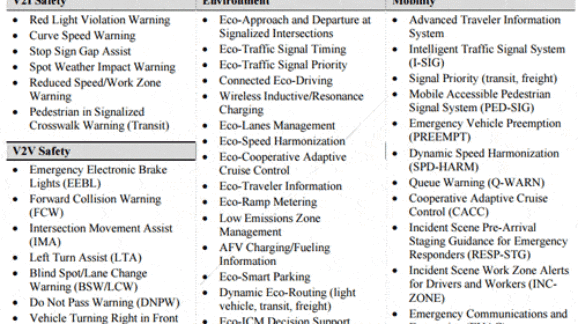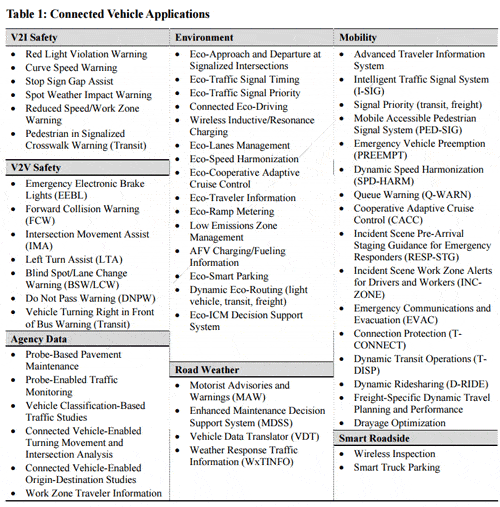Obama Highway Administration Released Troubling Vehicle Communications Guidance

Last Thursday, the outgoing Obama Federal Highway Administration (FHWA) released its long-awaited guidance document on the deployment of vehicle-to-infrastructure (V2I) communications. V2I refers to a suite of connected vehicle technologies and services that allow vehicles to wirelessly “talk” to infrastructure to provide, at least as currently envisioned, hazard warnings and roadway conditions information to drivers. Below is a table of some of the services that could potentially be offered by connected vehicle technologies:

Deploying V2I may prove beneficial in the future. Unfortunately, just like the National Highway Traffic Safety Administration’s (NHTSA) deeply flawed proposal to mandate vehicle-to-vehicle (V2V) communications for all new light-duty vehicles, FHWA’s V2I guidance document assumes the reliance on a specific communications protocol known as dedicated short-range communications (DSRC).
In 2014, in response to NHTSA’s advance notice of proposed rulemaking on V2V, I noted that relying on DSRC unnecessarily raises the costs and timeframe of connected vehicle technology deployment:
For DSRC to be effective, roadside equipment (“RSE”) units would need to be installed perhaps as close as 400 meters apart. The cost of such a system, presumably publicly funded, makes it an unattractive option. After all, merely reconstructing current Interstate Highway System infrastructure to meet basic modern standards is estimated to cost in the $600 billion–$1 trillion range over the next 20 years. It remains to be seen how federal and state transportation agencies will pay for new DSRC RSE units, as current revenue sources are proving inadequate for basic infrastructure maintenance and reconstruction.
One potential alternative to DSRC V2V connection is cellular. NHTSA does contemplate this alternative, although it does not mention recent advancements in LongTerm Evolution (“LTE”) cellular services that may be able to offer more rapidly deployable V2V systems at lower costs. For instance, Nokia earlier this year announced its Liquid Applications LTE network system. This would rely on edge computing to transform, in Nokia’s words, “a regular LTE base station into a roadside unit for vehicle-to-infrastructure (V2I) communications.”
Furthermore, harnessing existing wireless networks will not only reduce costs, it will harness the superior expertise of the wireless industry. As Roger Lanctot of Strategy Analytics notes, “The U.S. Department of Transportation needs to take a closer look at wireless phones as a means for achieving communications between vehicles or between vehicles and their drivers and infrastructure. Mandating a module is a dead end deal.”
One advantage V2I has over V2V, however, is that users could potentially experience benefits much earlier. Under V2V, a V2V-equipped vehicle would need to encounter another V2V-equipped vehicle in order to realize any service benefits. Given that the average age of a light-duty vehicle now exceeds 11 years and fleet turnover continues to slow, the probability of this occurring in the early years of deployment is exceedingly low. Under V2I, roadside cameras and sensors could potentially allow a V2X-equipped vehicle to benefit from, say, Red Light Violation Warning if the infrastructure at the intersection is properly deployed and configured.
But locking in DSRC as the legal connected vehicle protocol still carries risks. The spectrum block currently dedicated to DSRC-only use is extremely valuable and is being chased by developers and users of Wi-Fi products. Private-sector solutions, namely the forthcoming deployment of 5G cellular, have the potential to not only save taxpayers a great deal of money, but to increase the speed of deployment and realization of V2X benefits. Further, just like NHTSA’s proposed V2V mandate, FHWA’s V2I guidance does not meaningfully address far more promising automated vehicle technology, nor are major challenges related to privacy and cybersecurity adequately resolved.
I have urged the new administration to withdraw NHTSA’s proposed V2V mandate. Similarly, the administration should discard the past administration’s near-religious adherence to DSRC and reexamine FHWA’s V2I guidance.